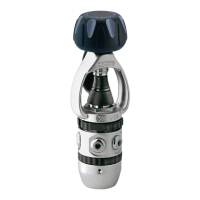suddenly removed or the self-breathing apparatus falls into the
water, can generate even violent high air-consumption free-
flowing. The dive position (+) must exclusively be used under-
water and only when the regulator is positioned inside the
mouth.
When the diver is breathing, he generates an increase in the pres-
sure inside the regulator casing which opens the oblique elliptical
release valve whose larger diameter makes it possible for the air
to exit outwards. The exhaust port delivers the air to the sides of
the head and prevents the valve being opened because of poten-
tial water turbulence, or from being flooded whenever the inner
case is not being pressurized.
Another special feature to be found in Cressi-Sub’s second-stage
regulators comes into play when the regulator is used in cold wa-
ters (water temperature of <10°C or 50°F), a feature engineered
with great precision and detailed attention and made possible
thanks to the special design of the regulator’s valve unit.
Indeed the valve unit’s internal flap takes advantage of the temper-
ature increase generated by the diver when he/she exhales,
specifically around the nozzle area of the valve, where the risk of
freezing is the highest. This patented system greatly enhances the
regulator’s freeze-resistance.
WARNING: for diving in cold waters (temperature <10°C)
Cressi-Sub recommends the use of a tank with a pillar valve
with two independent outputs, to which two complete regula-
tors can be connected.
WARNING: adequate technical preparation is required be-
fore undertaking cold water diving (temperature <10°C).
Cressi-Sub recommends undertaking this type of diving only
after having taken a specific training course with qualified in-
structors. The use of diving equipment in cold water without a
certification or adequate technical preparation is potentially
dangerous for the diver's health and wellbeing.
It is important not to wet the regulator before use (it would then be
exposed to an air temperature of potentially well under zero de-
grees).
Do not use the purge button, particularly when the adjustable Ven-
turi effect knob is in the “dive” position. If possible, keep the regu-
lator in a warm environment before use.
The Cressi-Sub balanced second-stage regulators are connected
to one of the 3/8” ports of the first-stage via a new medium-pres-
sure, high-capacity flexible hose in thermoplastic, a material which
has excellent mechanical qualities, very high elastic flexibility and
remains anti-kink in any situation due to its internal structure. This
high-performance material, combined with the regulators’ special
aesthetically pleasing look and scratch-resistant features make
them unique on the current market. Production batches per tube
and fittings are labelled according to standard EN 250:2014.
All Cressi-Sub second-stage regulators are downstream, i.e.
equipped with an automatic valve opening in the event of first-
stage calibration loss or a sudden increase in intermediate pres-
sure.
This means that any excess upstream pressure on the second-
stage will never lead to the regulator getting blocked but indeed to
spontaneous free-flowing.
The casing of Cressi-Sub second-stage balanced regulators is
made of new engineered fabrics with impressive mechanical qual-
ities and characteristics, noise-absorption being one of them.
The new cap (only in the adjustable version) is aesthetically pleas-
ing and designed with special etched Titanium, a material of unsur-
passable lightness and corrosion resistance.
The aforementioned cap is computer-designed and the various
water passages in the frontal parts of the casing have been thor-
oughly studied in order to enhance and improve the already im-
pressively high level of performance of Cressi-Sub second-stage
regulators.
Cressi-Sub second-stage regulators meet the requirements set
by standard EU 250:2014 in compliance with regulation UE
64
SECOND STAGES

